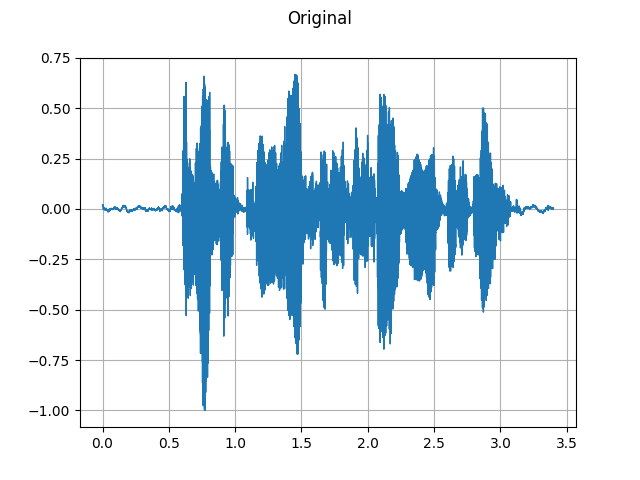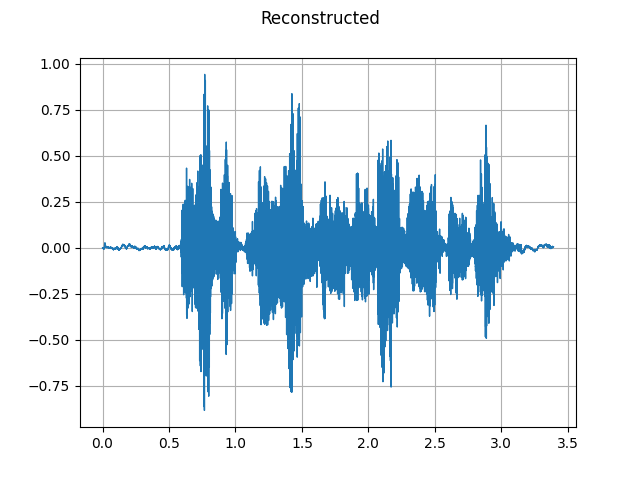Note
Click here to download the full example code
Audio Feature Extractions
torchaudio implements feature extractions commonly used in the audio
domain. They are available in torchaudio.functional and
torchaudio.transforms.
functional implements features as standalone functions.
They are stateless.
transforms implements features as objects,
using implementations from functional and torch.nn.Module. Because all
transforms are subclasses of torch.nn.Module, they can be serialized
using TorchScript.
For the complete list of available features, please refer to the
documentation. In this tutorial, we will look into converting between the
time domain and frequency domain (Spectrogram, GriffinLim,
MelSpectrogram).
# When running this tutorial in Google Colab, install the required packages
# with the following.
# !pip install torchaudio librosa
import torch
import torchaudio
import torchaudio.functional as F
import torchaudio.transforms as T
print(torch.__version__)
print(torchaudio.__version__)
Out:
1.11.0+cpu
0.11.0+cpu
Preparing data and utility functions (skip this section)
# @title Prepare data and utility functions. {display-mode: "form"}
# @markdown
# @markdown You do not need to look into this cell.
# @markdown Just execute once and you are good to go.
# @markdown
# @markdown In this tutorial, we will use a speech data from [VOiCES dataset](https://iqtlabs.github.io/voices/),
# @markdown which is licensed under Creative Commos BY 4.0.
# -------------------------------------------------------------------------------
# Preparation of data and helper functions.
# -------------------------------------------------------------------------------
import os
import librosa
import matplotlib.pyplot as plt
import requests
from IPython.display import Audio, display
_SAMPLE_DIR = "_assets"
SAMPLE_WAV_SPEECH_URL = "https://pytorch-tutorial-assets.s3.amazonaws.com/VOiCES_devkit/source-16k/train/sp0307/Lab41-SRI-VOiCES-src-sp0307-ch127535-sg0042.wav" # noqa: E501
SAMPLE_WAV_SPEECH_PATH = os.path.join(_SAMPLE_DIR, "speech.wav")
os.makedirs(_SAMPLE_DIR, exist_ok=True)
def _fetch_data():
uri = [
(SAMPLE_WAV_SPEECH_URL, SAMPLE_WAV_SPEECH_PATH),
]
for url, path in uri:
with open(path, "wb") as file_:
file_.write(requests.get(url).content)
_fetch_data()
def _get_sample(path, resample=None):
effects = [["remix", "1"]]
if resample:
effects.extend(
[
["lowpass", f"{resample // 2}"],
["rate", f"{resample}"],
]
)
return torchaudio.sox_effects.apply_effects_file(path, effects=effects)
def get_speech_sample(*, resample=None):
return _get_sample(SAMPLE_WAV_SPEECH_PATH, resample=resample)
def print_stats(waveform, sample_rate=None, src=None):
if src:
print("-" * 10)
print("Source:", src)
print("-" * 10)
if sample_rate:
print("Sample Rate:", sample_rate)
print("Shape:", tuple(waveform.shape))
print("Dtype:", waveform.dtype)
print(f" - Max: {waveform.max().item():6.3f}")
print(f" - Min: {waveform.min().item():6.3f}")
print(f" - Mean: {waveform.mean().item():6.3f}")
print(f" - Std Dev: {waveform.std().item():6.3f}")
print()
print(waveform)
print()
def plot_spectrogram(spec, title=None, ylabel="freq_bin", aspect="auto", xmax=None):
fig, axs = plt.subplots(1, 1)
axs.set_title(title or "Spectrogram (db)")
axs.set_ylabel(ylabel)
axs.set_xlabel("frame")
im = axs.imshow(librosa.power_to_db(spec), origin="lower", aspect=aspect)
if xmax:
axs.set_xlim((0, xmax))
fig.colorbar(im, ax=axs)
plt.show(block=False)
def plot_waveform(waveform, sample_rate, title="Waveform", xlim=None, ylim=None):
waveform = waveform.numpy()
num_channels, num_frames = waveform.shape
time_axis = torch.arange(0, num_frames) / sample_rate
figure, axes = plt.subplots(num_channels, 1)
if num_channels == 1:
axes = [axes]
for c in range(num_channels):
axes[c].plot(time_axis, waveform[c], linewidth=1)
axes[c].grid(True)
if num_channels > 1:
axes[c].set_ylabel(f"Channel {c+1}")
if xlim:
axes[c].set_xlim(xlim)
if ylim:
axes[c].set_ylim(ylim)
figure.suptitle(title)
plt.show(block=False)
def play_audio(waveform, sample_rate):
waveform = waveform.numpy()
num_channels, num_frames = waveform.shape
if num_channels == 1:
display(Audio(waveform[0], rate=sample_rate))
elif num_channels == 2:
display(Audio((waveform[0], waveform[1]), rate=sample_rate))
else:
raise ValueError("Waveform with more than 2 channels are not supported.")
def plot_mel_fbank(fbank, title=None):
fig, axs = plt.subplots(1, 1)
axs.set_title(title or "Filter bank")
axs.imshow(fbank, aspect="auto")
axs.set_ylabel("frequency bin")
axs.set_xlabel("mel bin")
plt.show(block=False)
def plot_pitch(waveform, sample_rate, pitch):
figure, axis = plt.subplots(1, 1)
axis.set_title("Pitch Feature")
axis.grid(True)
end_time = waveform.shape[1] / sample_rate
time_axis = torch.linspace(0, end_time, waveform.shape[1])
axis.plot(time_axis, waveform[0], linewidth=1, color="gray", alpha=0.3)
axis2 = axis.twinx()
time_axis = torch.linspace(0, end_time, pitch.shape[1])
axis2.plot(time_axis, pitch[0], linewidth=2, label="Pitch", color="green")
axis2.legend(loc=0)
plt.show(block=False)
def plot_kaldi_pitch(waveform, sample_rate, pitch, nfcc):
figure, axis = plt.subplots(1, 1)
axis.set_title("Kaldi Pitch Feature")
axis.grid(True)
end_time = waveform.shape[1] / sample_rate
time_axis = torch.linspace(0, end_time, waveform.shape[1])
axis.plot(time_axis, waveform[0], linewidth=1, color="gray", alpha=0.3)
time_axis = torch.linspace(0, end_time, pitch.shape[1])
ln1 = axis.plot(time_axis, pitch[0], linewidth=2, label="Pitch", color="green")
axis.set_ylim((-1.3, 1.3))
axis2 = axis.twinx()
time_axis = torch.linspace(0, end_time, nfcc.shape[1])
ln2 = axis2.plot(time_axis, nfcc[0], linewidth=2, label="NFCC", color="blue", linestyle="--")
lns = ln1 + ln2
labels = [l.get_label() for l in lns]
axis.legend(lns, labels, loc=0)
plt.show(block=False)
Spectrogram
To get the frequency make-up of an audio signal as it varies with time,
you can use torchaudio.functional.Spectrogram().
waveform, sample_rate = get_speech_sample()
n_fft = 1024
win_length = None
hop_length = 512
# define transformation
spectrogram = T.Spectrogram(
n_fft=n_fft,
win_length=win_length,
hop_length=hop_length,
center=True,
pad_mode="reflect",
power=2.0,
)
# Perform transformation
spec = spectrogram(waveform)
print_stats(spec)
plot_spectrogram(spec[0], title="torchaudio")
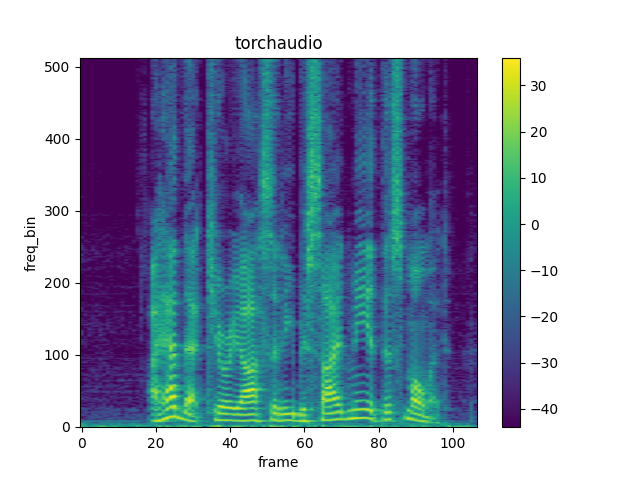
Out:
Shape: (1, 513, 107)
Dtype: torch.float32
- Max: 4000.533
- Min: 0.000
- Mean: 5.726
- Std Dev: 70.301
tensor([[[7.8743e+00, 4.4462e+00, 5.6781e-01, ..., 2.7694e+01,
8.9546e+00, 4.1289e+00],
[7.1094e+00, 3.2595e+00, 7.3520e-01, ..., 1.7141e+01,
4.4812e+00, 8.0840e-01],
[3.8374e+00, 8.2490e-01, 3.0779e-01, ..., 1.8502e+00,
1.1777e-01, 1.2369e-01],
...,
[3.4699e-07, 1.0605e-05, 1.2395e-05, ..., 7.4096e-06,
8.2065e-07, 1.0176e-05],
[4.7173e-05, 4.4330e-07, 3.9445e-05, ..., 3.0623e-05,
3.9746e-07, 8.1572e-06],
[1.3221e-04, 1.6440e-05, 7.2536e-05, ..., 5.4662e-05,
1.1663e-05, 2.5758e-06]]])
GriffinLim
To recover a waveform from a spectrogram, you can use GriffinLim.
torch.random.manual_seed(0)
waveform, sample_rate = get_speech_sample()
plot_waveform(waveform, sample_rate, title="Original")
play_audio(waveform, sample_rate)
n_fft = 1024
win_length = None
hop_length = 512
spec = T.Spectrogram(
n_fft=n_fft,
win_length=win_length,
hop_length=hop_length,
)(waveform)
griffin_lim = T.GriffinLim(
n_fft=n_fft,
win_length=win_length,
hop_length=hop_length,
)
waveform = griffin_lim(spec)
plot_waveform(waveform, sample_rate, title="Reconstructed")
play_audio(waveform, sample_rate)
Out:
<IPython.lib.display.Audio object>
<IPython.lib.display.Audio object>
Mel Filter Bank
torchaudio.functional.melscale_fbanks() generates the filter bank
for converting frequency bins to mel-scale bins.
Since this function does not require input audio/features, there is no
equivalent transform in torchaudio.transforms().
n_fft = 256
n_mels = 64
sample_rate = 6000
mel_filters = F.melscale_fbanks(
int(n_fft // 2 + 1),
n_mels=n_mels,
f_min=0.0,
f_max=sample_rate / 2.0,
sample_rate=sample_rate,
norm="slaney",
)
plot_mel_fbank(mel_filters, "Mel Filter Bank - torchaudio")
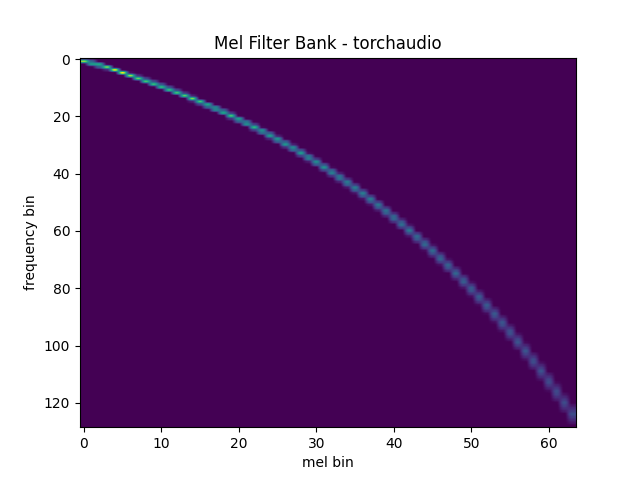
Comparison against librosa
For reference, here is the equivalent way to get the mel filter bank
with librosa.
mel_filters_librosa = librosa.filters.mel(
sr=sample_rate,
n_fft=n_fft,
n_mels=n_mels,
fmin=0.0,
fmax=sample_rate / 2.0,
norm="slaney",
htk=True,
).T
plot_mel_fbank(mel_filters_librosa, "Mel Filter Bank - librosa")
mse = torch.square(mel_filters - mel_filters_librosa).mean().item()
print("Mean Square Difference: ", mse)
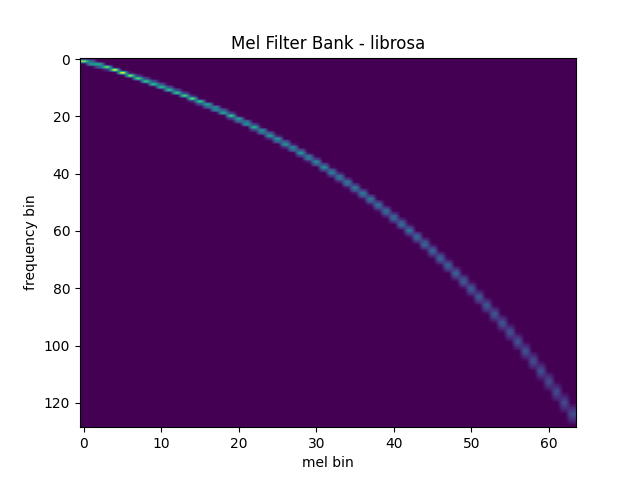
Out:
Mean Square Difference: 3.795462323290159e-17
MelSpectrogram
Generating a mel-scale spectrogram involves generating a spectrogram
and performing mel-scale conversion. In torchaudio,
torchaudio.transforms.MelSpectrogram() provides
this functionality.
waveform, sample_rate = get_speech_sample()
n_fft = 1024
win_length = None
hop_length = 512
n_mels = 128
mel_spectrogram = T.MelSpectrogram(
sample_rate=sample_rate,
n_fft=n_fft,
win_length=win_length,
hop_length=hop_length,
center=True,
pad_mode="reflect",
power=2.0,
norm="slaney",
onesided=True,
n_mels=n_mels,
mel_scale="htk",
)
melspec = mel_spectrogram(waveform)
plot_spectrogram(melspec[0], title="MelSpectrogram - torchaudio", ylabel="mel freq")
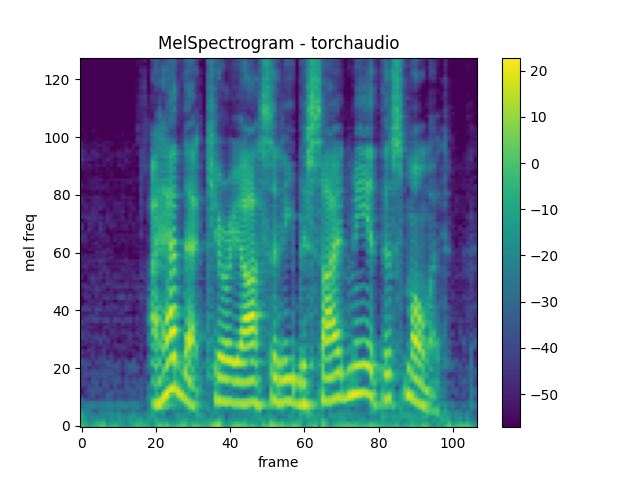
Comparison against librosa
For reference, here is the equivalent means of generating mel-scale
spectrograms with librosa.
melspec_librosa = librosa.feature.melspectrogram(
y=waveform.numpy()[0],
sr=sample_rate,
n_fft=n_fft,
hop_length=hop_length,
win_length=win_length,
center=True,
pad_mode="reflect",
power=2.0,
n_mels=n_mels,
norm="slaney",
htk=True,
)
plot_spectrogram(melspec_librosa, title="MelSpectrogram - librosa", ylabel="mel freq")
mse = torch.square(melspec - melspec_librosa).mean().item()
print("Mean Square Difference: ", mse)
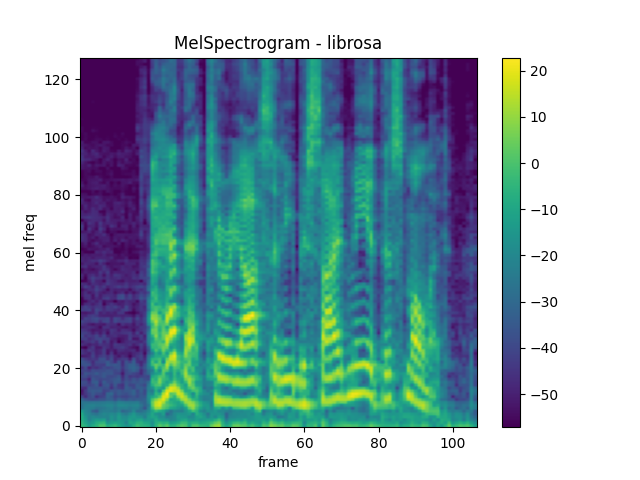
Out:
Mean Square Difference: 1.1827383517015733e-10
MFCC
waveform, sample_rate = get_speech_sample()
n_fft = 2048
win_length = None
hop_length = 512
n_mels = 256
n_mfcc = 256
mfcc_transform = T.MFCC(
sample_rate=sample_rate,
n_mfcc=n_mfcc,
melkwargs={
"n_fft": n_fft,
"n_mels": n_mels,
"hop_length": hop_length,
"mel_scale": "htk",
},
)
mfcc = mfcc_transform(waveform)
plot_spectrogram(mfcc[0])
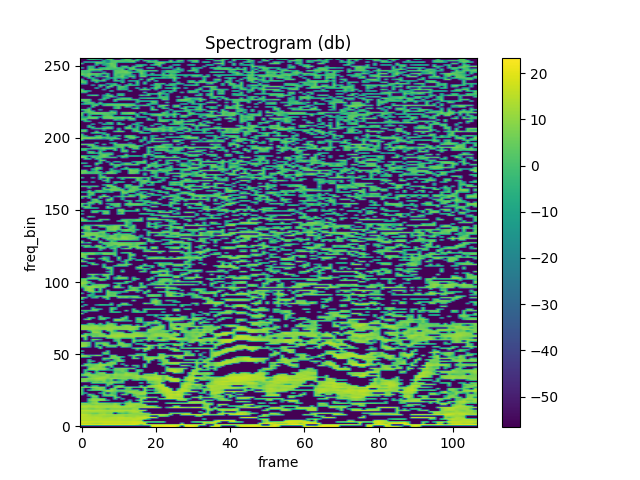
Comparing against librosa
melspec = librosa.feature.melspectrogram(
y=waveform.numpy()[0],
sr=sample_rate,
n_fft=n_fft,
win_length=win_length,
hop_length=hop_length,
n_mels=n_mels,
htk=True,
norm=None,
)
mfcc_librosa = librosa.feature.mfcc(
S=librosa.core.spectrum.power_to_db(melspec),
n_mfcc=n_mfcc,
dct_type=2,
norm="ortho",
)
plot_spectrogram(mfcc_librosa)
mse = torch.square(mfcc - mfcc_librosa).mean().item()
print("Mean Square Difference: ", mse)
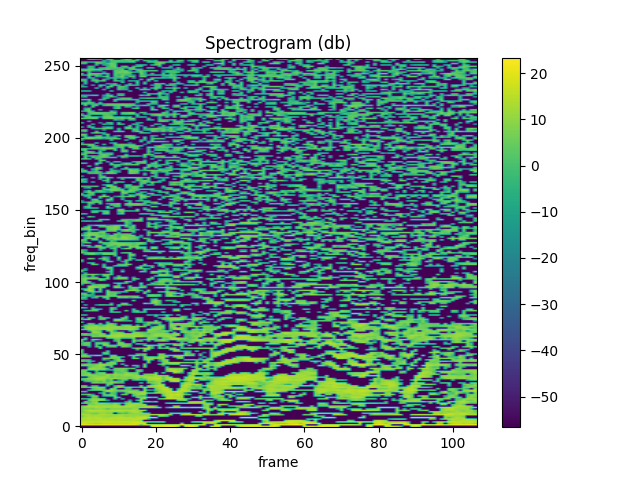
Out:
Mean Square Difference: 1.0665760040283203
Pitch
waveform, sample_rate = get_speech_sample()
pitch = F.detect_pitch_frequency(waveform, sample_rate)
plot_pitch(waveform, sample_rate, pitch)
play_audio(waveform, sample_rate)
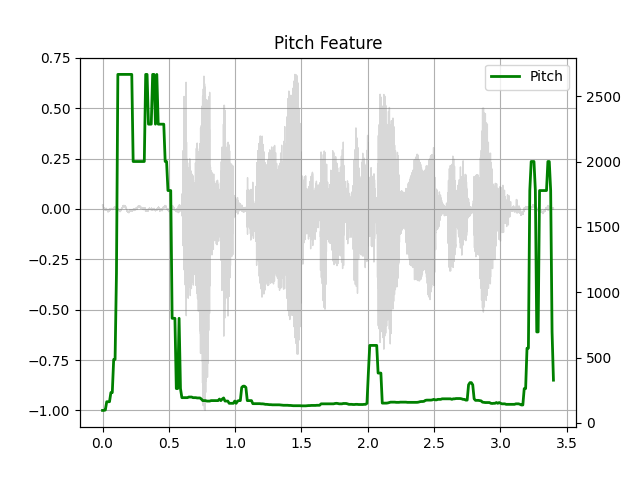
Out:
<IPython.lib.display.Audio object>
Kaldi Pitch (beta)
Kaldi Pitch feature [1] is a pitch detection mechanism tuned for automatic
speech recognition (ASR) applications. This is a beta feature in torchaudio,
and it is available as torchaudio.functional.compute_kaldi_pitch().
A pitch extraction algorithm tuned for automatic speech recognition
Ghahremani, B. BabaAli, D. Povey, K. Riedhammer, J. Trmal and S. Khudanpur
2014 IEEE International Conference on Acoustics, Speech and Signal Processing (ICASSP), Florence, 2014, pp. 2494-2498, doi: 10.1109/ICASSP.2014.6854049. [abstract], [paper]
waveform, sample_rate = get_speech_sample(resample=16000)
pitch_feature = F.compute_kaldi_pitch(waveform, sample_rate)
pitch, nfcc = pitch_feature[..., 0], pitch_feature[..., 1]
plot_kaldi_pitch(waveform, sample_rate, pitch, nfcc)
play_audio(waveform, sample_rate)
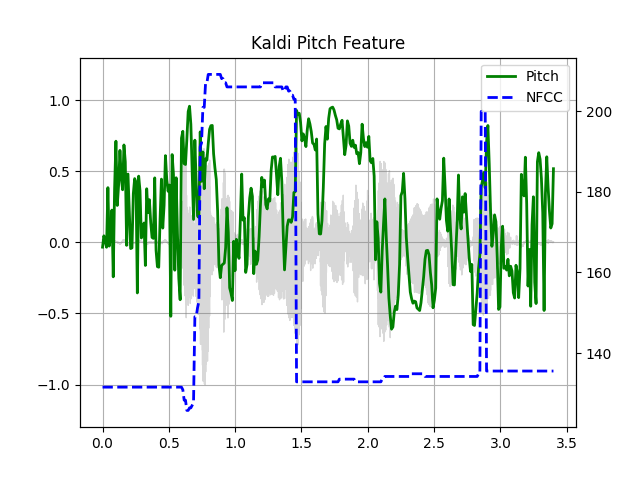
Out:
<IPython.lib.display.Audio object>
Total running time of the script: ( 0 minutes 4.249 seconds)



